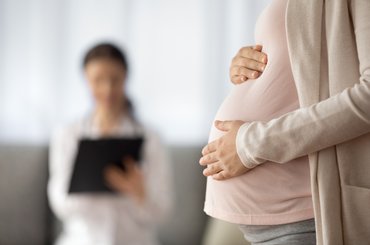
This blog post was published when our programme was part of the Healthcare Safety Investigation Branch (HSIB). Find out about HSIB legacy.
It will not have escaped your notice that maternity care is under increasing scrutiny when it comes to patient safety.
Independent review such as “Better births: improving outcomes of maternity services in England” notes that women want healthcare professionals to be able to “[recognise] signs of changing risk and [escalate] the care, when necessary in a timely manner” (National maternity review, 2016). An independent review of maternity services at the Shrewsbury and Telford Hospital NHS Trust, known as the Ockenden report, identifies risk assessment throughout pregnancy as one of the 12 clinical priorities for immediate action on the part of all Trusts. The report lists the following as an essential action: “staff must ensure that women undergo a risk assessment at each contact throughout the pregnancy pathway.”
There are numerous national guidelines that talk about risk assessments in maternity care including the Royal College of Obstetricians & Gynaecologists, National Institute for Health Care and Excellence and NHS England. At the time of writing, there is no single national standard for risk assessment in maternity care.
But what do we mean by risk assessment in maternity care?
Risk assessment during the maternity pathway relies on healthcare professionals recognising a change in a pregnant woman’s circumstances that may increase the level of risk and these risk assessments are undertaken during numerous contacts across the maternity pathway.
Risk assessment is a dynamic process (meaning the risk is continually assessed to allow for unknown factors and to handle uncertainty) and health care professionals should understand that a pregnant woman’s risk-profile may change during their pregnancy, labour, birth and post birth care.
Maternity investigations
We started our report on risk assessments in maternity care after noting evidence within our maternity investigation programme indicating that risk assessment in the maternity pathway remains a significant challenge.
Our maternity investigations had identified repeated examples of insufficiently robust, continuous risk assessment in the maternity pathway. This may have led to pregnant women being on the incorrect care pathway or being in the wrong place of care for their pregnancy or labour, which in turn may have delayed decision making or timely escalation of care to meet the needs of the pregnant woman and their baby.
Themes of risk assessment
The national learning report concentrated on six key themes that were found within our maternity investigation programme. These themes and findings led to producing 13 prompts for NHS trusts to consider how these risks may be mitigated.
These themes are:
- Risk assessment and language. The language used to discuss and document risk assessments should encourage a dynamic and holistic assessment of the individual pregnant woman’s risk that promotes the need for maternity care to be provided by multi-professional teams.
- Risk assessment and clinical oversight. Risk assessment should allow for a holistic consideration and not focus on single risk factors.
- Risk assessment and triage. Telephone triage services should be operated 24 hours a day by appropriately trained and competent staff equipped with the specific needs required for telephone triage. Face to face triage should use a structured approach to prioritise pregnant women in order of clinical need.
- Risk assessment and place of birth. Staff should be enabled to proactively monitor and recommend the place of labour care and birth for pregnant women based on the individual’s specific care needs during the course of their pregnancy and labour.
- Risk assessment and previous caesarean birth. Each pregnant woman should be helped to understand their individualised risks associated with vaginal or caesarean birth to enable supported decision making.
- Risk assessment and induction of labour. Pregnant women whose labour has been induced need clinical oversight and an individualised plan of care for maternal and fetal well-being.
Time for change?
Risk assessments in maternity care often result in limited options for categorising risk - for example, “low risk” or “high risk”. The use of low or high risk has been described by healthcare professionals as restrictive and may result in people thinking the level of risk cannot change. In addition, such terms can be seen as judgemental and these labels may heavily influence the choices of a pregnant woman.
Terms such as “midwifery led”, “obstetric led” or “shared care” may not always be helpful and have no clear meaning. Most pregnant women will be seen or reviewed by an obstetrician at some point in their pregnancy, labour or postnatal journey and it is unclear if this means they are obstetric led.
This language can influence the approach of healthcare professionals towards pregnant women, and lead to a potential for conflict among professionals. The recent Reading the Signals report, an independent review in maternity and neonatal services in East Kent (Kirkup, 2022) talked about gross failures of team working across the Trust’s maternity services and staff acting as if they were responsible for separate fiefdoms, cultivating a culture of tribalism. By labelling pregnant women as obstetric led or midwifery led can influence and add to categorisation within these territorial domains.
Is it time, therefore to stop labelling pregnant women and instead talk about personalised care?
Most pregnant women will have different needs during their pregnancy, labour and birth and postnatal care which will involve many different health professionals such as;
Midwives, sonographers, obstetricians, neonatologists, health visitors, perinatal mental health, physiotherapy, smoking cessation support and many more.
Therefore instead of trying to fit a round peg into a square hole by labelling pregnant women perhaps we instead look at each individual risk and how that affects the pregnancy and birth and how pregnancy and birth may affect the risks?
Related news

Changes to the MNSI investigation report template
Improving support after maternal deaths: is national guidance required?
Inspiring inclusion and empowering MNSI investigators
